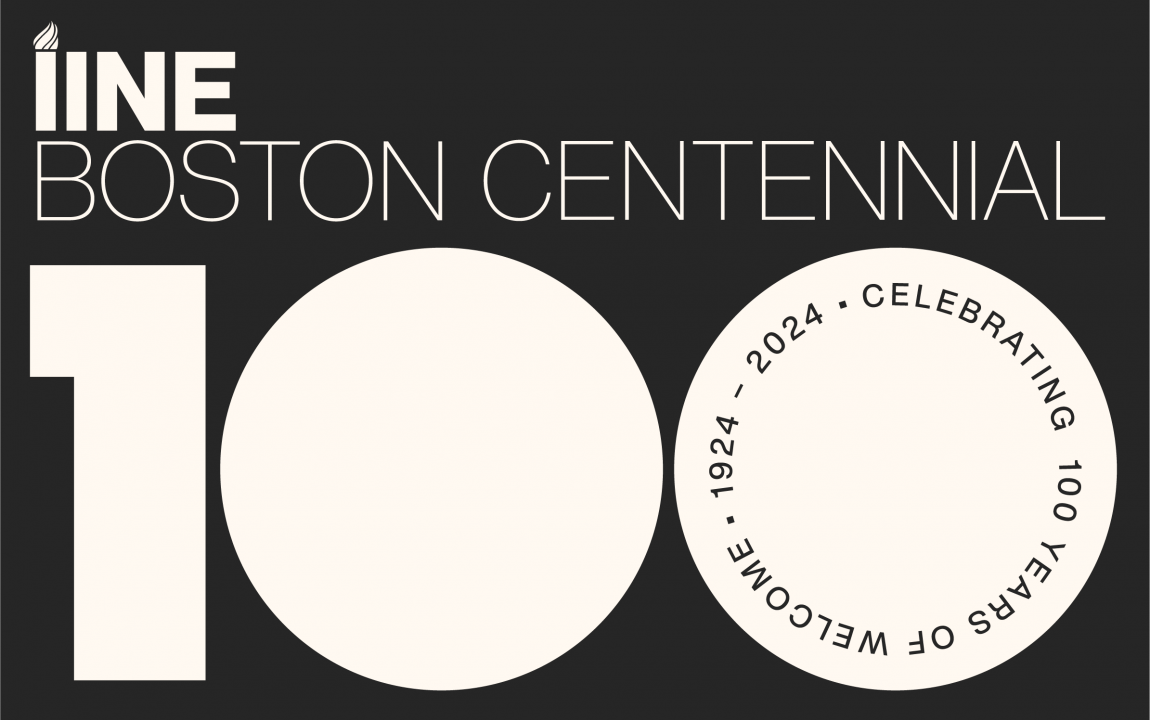1935-1944: “Don’t Condemn—Understand”
“100 Years of Welcome: Commemorating IINE’s Boston Centennial” Series:
Installment #3
Welcome to the third installment of our series, “100 Years of Welcome: Commemorating IINE’s Boston Centennial.” The previous installment, “1924-1934: Fostering Community,” described how the newly formed International Institute of Boston (IIB) provided a space to celebrate and support the city’s immigrant communities during a period of restricted immigration and economic hardship.
In the mid-1930s to mid-1940s, the International Institute of Boston navigated the Great Depression and the Second World War—a roiling sea of economic pressure, fear of both real and imagined enemies, and competing views of national loyalty.
During this period, IIB found ways to help U.S. soldiers in Boston and U.S. allies abroad; Jewish refugees fleeing the Nazis; and immigrants from the Axis countries of Japan, Italy, and Germany, while also pushing back against the discriminatory Chinese Exclusion Act and serving Boston’s Chinese community.
This remarkable balancing act began with a declaration of independence.
More International and “truly American”

At the beginning of the 1930’s, the International Institute of Boston had moved its offices from Boston’s YWCA at which it was founded, to its own offices on Beacon Street and expanded its initial focus from serving immigrant women and girls to serving all immigrants, with “Nationality Workers” drawn from Boston’s immigrant communities continuing to work directly with clients.
In 1935, IIB’s newsletter, The International Beacon, informed its membership that it was “eager to be even more ‘international’ and at the same time more truly American than ever before.”
First, it fully shed its association with the Boston’s Young Women’s Christian Association (YWCA). It would now be an “organization representative of men and women of various races, nations, and creeds,” governed by a board of directors that included members of the city’s immigrant community. This move would separate IIB from any singular religious affiliation in order to best serve immigrants of all faiths. As the Beacon explained, “the emergence of new American civic leaders,” from Boston’s immigrant communities, would enable IIB to welcome “young men and women of education and initiative” as “members and leaders as well as participants in activities.”
Second, expanding its connection to community partners, the newly independent IIB joined the Boston Council of Social Agencies, and solidifying its commitment to the national movement from which it emerged, joined the National Institute for Immigrant Welfare, later to be called the American Federation of International Institutes.
Third, there was some organizational rebuilding to do. Throughout the 1930s, the ravages of the Great Depression had led to significant cutbacks, including a reduction of staff. To recover, IIB founding Executive Secretary Georgia Ely launched the first International Institute of Boston Ball at the lavish Statler hotel. This festive fundraiser helped rally supporters to its cause by celebrating the contributions of Boston’s immigrant community. The event showcased international fashion, cuisine, and dance.
Continuing its commitment to cultural pluralism, in 1937 Marion Blackwell became IIB’s second Executive Secretary. An apt spokesperson for the International Institute movement, she wrote in a letter to the editor of Harenik, Boston’s Armenian newspaper, “I believe it is disastrous to sever old-country traditions and ties, and I do not believe in the melting pot idea which would make all people in America of one kind.” Independent and immigrant-driven, IIB reinforced the value of the diversity of those it welcomed and served.
Don’t Condemn—Understand!
In the late 1930s and early 1940s, under Marion Blackwell’s leadership, the International Institute of Boston continued to fiercely oppose discrimination against foreigners through advocacy. It successfully lobbied against proposed cruel and inhumane federal immigration legislation which, preying on the economic fears of the Depression, would have deported immigrants receiving government relief and created prison camps for those who could not be deported.
As the Second World War stoked mistrust of immigrants—specifically those from the Axis countries of Germany, Italy, and Japan—the International Institute of Boston was quick to defend them. In a note “From the Executive’s Desk” in its International Beacon newsletter, Marion Blackwell wrote, “DON’T CONDEMN—UNDERSTAND! This is the key word of International Institute philosophy…War necessitates certain regulations but does not require us as individuals to lose a sense of proportion. [We have] always espoused the cause of the less understood groups of foreign cultures.”
When activists could not ultimately prevent the U.S. government from creating wartime internment camps, the International Institute of Boston focused its efforts on supporting the reintegration of those who had been interred. In the early 1940s, IIB helped form the Nisei Hospitality Committee to assist Japanese nationals and Japanese Americans released from the camps. The International Institute housed the Committee, which aided roughly 600 camp evacuees in finding emergency housing and other vital services in Boston. It also worked to connect relocated internees, most of whom were students, with Nisei and Issei (first- and second-generation) Japanese families in Boston.
Multiple Fronts of Support in Wartime
As the U.S. entered the war against fascist forces abroad, Boston bustled with mobilization efforts. The Boston Navy Yard in Charlestown became the designated production site for destroyer ships and a hub for navy ship repairs of all kinds. An army base in South Boston sent supply ships to troops throughout Europe. Nearby Fort Devens received draftees from throughout New England and served as a training center for army combat soldiers, cooks, chaplains, and nurses.
The International Institute of Boston found every available path to help Boston’s immigrants and refugees during wartime. One focus was supporting second generation immigrants serving in the armed forces who were stationed in Boston during basic training, while awaiting deployment, or while on leave. Building on its success in connecting people through social gatherings and arts events, IIB worked with the Soldiers and Sailors Recreation Committee formed by city and state officials to host welcome celebrations and dances for local servicemembers and to connect them with local immigrant families of like cultures who invited them into their homes for holiday dinners. IIB helped fundraise for a committee called Defend the Allies that organized local groups to send aid to countries joining the U.S. in its fight. IIB’s Immigration legal support services became focused on ensuring that anyone not born in the U.S. who served in its uniform abroad would be granted entry to the U.S. and full citizenship in Boston.
Meanwhile, when the horrors perpetrated by the Nazis began creating a refugee crisis to which the U.S. was not yet receptive, IINE partnered with a local mutual aid association sponsoring small numbers of Jewish refugees to resettle in Boston. Taking up the cause, IIB provided new arrivals with English language instruction to help them integrate.

A final avenue for support of immigrants opened when the U.S. formed an alliance with China. The International Institute lobbied hard to repeal the national Chinese Exclusion Act which had slammed the door on Chinese immigrants for decades. Once the act was successfully repealed in 1942, IIB hired its first Chinese “Nationality Secretary,” a Chinese immigrant who would lead IIB’s effort to serve the city’s Chinese community, including reunifying families who had been separated by the quota system that had replaced the Exclusion Act.
Today, the Boston offices of the International Institute of New England reside in the China Trade Center on the border of the Boston Chinatown Neighborhood. Within these offices, the International Institute continues to employ a diverse staff representative of the people IINE serves and to work with both local and national partners to find every available path to welcome newcomers who need our support and who renew Boston’s communities.
During our centennial year, we celebrate 100 years of life-changing support to refugees and immigrants in Greater Boston and prepare for our second century of service. Learn more here: IINE Boston Centennial.
Related Articles

Suitcase Stories®: Ishtar, a Haitian Immigrant, Shares Why She Came and Why She Stays

Q&A With New Board Member Richard Golob
